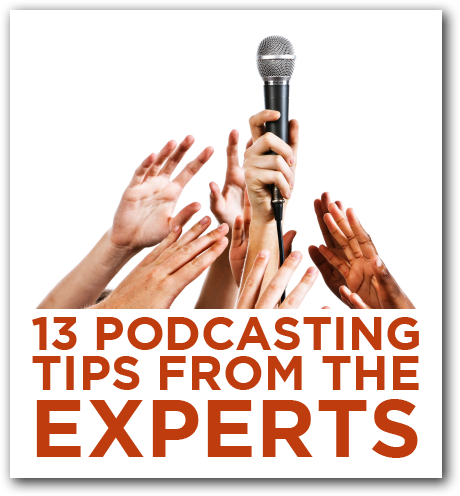 I considered calling this article “13 Expert Podcasting Tips from The Experts,” but it felt too Spinal Tap for me.
I considered calling this article “13 Expert Podcasting Tips from The Experts,” but it felt too Spinal Tap for me.
If there is such a thing.
There’s a “Podcasting Renaissance” going on right now. Businesses and Internet marketers are realizing the benefits of having their own podcast…their own Internet radio show.
The benefits of podcasting are plentiful:
- Creating a podcast is simple and inexpensive (although you can certainly make it difficult and expensive if that’s how you roll.)
- You have a captive audience, because people often listen to podcasts while they’re doing something that keeps them from reading or watching videos, like driving in their car or running on a treadmill.
- You are quite literally inside your audience’s head, and they feel like they know you.
- People subscribe to your podcast, so it’s delivered to them automatically, not unlike an email newsletter.
Since I’m no podcasting expert, I decided to tap some friends who were. Here are expert podcasting tips from 13 professionals who are knocking it out of the park.
Just Do It

He is also a blogger, podcaster and WebTV Show host, as well as being the creator of the free 7-Day New Business Bootcamp!
Have a Plan & System for Your Podcast
Podcasting is an excellent medium to share content, and is showing signs of resurgence with a number of thought leaders and professional now entering (or re-entering) the Podcast arena.
In a recent interview, Chris Brogan was asked this question — If you had to give up one of your platforms, which one would it be? His answer — I would give up my blog and would keep my podcast and newsletter.
If you’re considering starting a podcast, the best advise I can give you is to have plan and system for success. Podcasting doesn’t have to be difficult, but you must be committed and consistent if you want to grow your audience and have an impact.
You can have the best equipment, intro music and website, but those things alone don’t guarantee success.
I recommend looking at your podcast as a project – a defined beginning and end. One way to do this is to set up a checklist or workflow for each episode. Here’s an example of my workflow (which I actually maintain in a project management system):
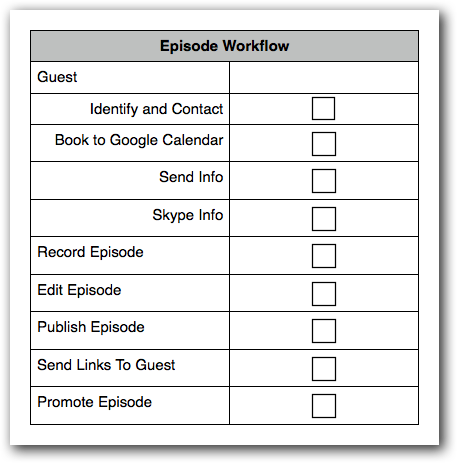 In addition to my workflow checklist, I also have templates for show emails, follow-ups, prerecorded intro’s and outro’s and video Screenflow templates, which allow me to stay focused and save time. I simply drop the new info into my pre-formatted processes.
In addition to my workflow checklist, I also have templates for show emails, follow-ups, prerecorded intro’s and outro’s and video Screenflow templates, which allow me to stay focused and save time. I simply drop the new info into my pre-formatted processes.
My systems and process make the production of my podcast appear seamless and definitely keep me committed and consistent.
Tools I use: Google Calendar, Podio Project Management Software, Screenflow, Skype, Ecamm Call Recorder, Libysn and WordPress.
Shelia Butler is a Business Consultant and host of the WebTV show Successful Women Talk. She also owns and operates Me Giant Inc. – a children’s line of room decor and accessories.
Launch Big or Go Home
 When bringing a podcast into the world, launch day is of utmost importance.
When bringing a podcast into the world, launch day is of utmost importance.
iTunes currently rules the roost in terms of podcast traffic, and they have given newbie podcasters a gift beyond value that goes by the name of “New and Noteworthy”. When one arrives at the iTunes podcast store, the absolute best real estate commanding the top two rows and much of the visible screen, is the new and noteworthy section.
From launch date, you have 8 glorious weeks of eligibility to be one of the top 100 “New and Noteworthy” podcasts. The value in being near the top of this list is immeasurable, however 99% of podcasters do not take advantage of this opportunity.
EntrepreneurOnFire was ranked as the #1 business podcast on new and noteworthy for 8 straight weeks, and the amount of organic traffic that resulted was massive.
The action steps needed to ensure you take full advantage of this is as follows:
- Release a minimum of 3 podcasts on launch day.
- Spend that first week reaching out to your audience asking them to download all 3, and leave a rating and review.
The reasoning behind releasing 3 is a simple math equation: 100 subscribers in the first week will give you 300 downloads, as opposed to 100. This will propel you into the new and noteworthy section, and once there, the snowball effect will take over and you can sit back and watch your podcast climb higher in the rankings each day.
John Lee Dumas is the Founder and Host of EntrepreneurOnFire, a business podcast that interviews todays most inspiring and successful Entrepreneurs 5-days a week. Past guests include Barbara Corcoran, Gary Vaynerchuk, Seth Godin, Guy Kawasaki, and many, many more. Visit EntrepreneurOnFire.com to experience the journey of these incredible Entrepreneurs.
Hire a Professional Voice
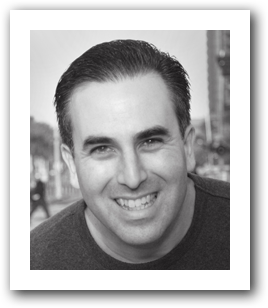 Get a professional voice talent to record your introduction and outro.
Get a professional voice talent to record your introduction and outro.
A voice talent can add a certain flare of professionalism that can set your podcast apart from others. For the Social Media Marketing podcast we hired John Melley and asked him to do an Australian accent. It made a huge difference in our production value.
Michael Stelzner is the founder of Social Media Examiner and the Social Media Marketing Podcast. He’s the man behind Social Media Marketing World–the largest social media marketing conference.
Be Thankful for the Audience You Have
 In essence, when you super serve those who are already following you, those folks will eventually be the ones who promote you and your podcast best.
In essence, when you super serve those who are already following you, those folks will eventually be the ones who promote you and your podcast best.
Cliff Ravenscraft is the Podcast Answer Man. He is a podcast producer, consultant and coach, and offers a Podcasting A to Z online coaching course.
Your Podcast Ranking is Important
Just like with Google results, the top rankings get most of the traffic. So when you decide to create a podcast, shoot for being in the top 5%.
Do everything with excellence and make it worth your time!
Jaime Tardy is the founder of Eventual Millionaire, where she interviews millionaires for her weekly podcast.
Length Is Important
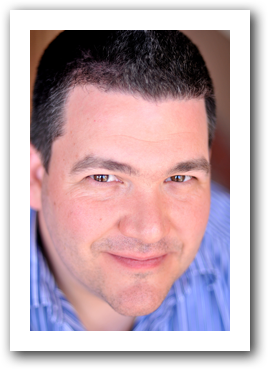 Remember my miniskirt philosophy for content because it is very important when it comes to podcasts.
Remember my miniskirt philosophy for content because it is very important when it comes to podcasts.
Make it as long as necessary to cover the essentials, but short enough to keep it interesting.
Drive People to Your Website or Blog
 A podcast is great, but nobody can click a sound – you MUST get people to come back to your website or blog from your podcast.
A podcast is great, but nobody can click a sound – you MUST get people to come back to your website or blog from your podcast.
There are several ways to do this, but the best way is to have amazing, detailed show notes.
During the show, let your audience relax while reminding them that they can always come back to your site to get all of the links and items mentioned in that particular show. It’s a win for your listeners because they don’t have to scramble looking for links or having to play back certain segments of your show, and it’s a win for you because you’ll drive more traffic to your site where all of the action happens.
Try to make the journey to your show notes as easy as possible, whether though a short redirect link such as http://www.smartpassiveincome.
Pat Flynn is the owner of SmartPassiveIncome.com where he has an audience of over 60,000 subscribers who learn from his blog and top-rated iTunes podcast about online business and blogging techniques.
His podcast has had over 2.5 million downloads in the last two years and he has recently been recognized in both Forbes and the New York Times for his work.
Create Content You Would Want to Listen To
 Podcasting, more than blogging and social media, can have a reach that is remarkably unique.
Podcasting, more than blogging and social media, can have a reach that is remarkably unique.
Why? Because first, you are in someone’s earbuds. They are listening to you and if you create great content and deliver it with sincerity and enthusiasm, you will make a remarkable connection with your listener. That is the power of podcasting.
Second, iTunes and other podcasting outlets reach a different audience than your blog, and last but not least, I have found that it takes people one or two podcasts to become a true fan whereas it takes them several blog posts to really feel the same.
My tips for podcasting is to first, create content that you yourself would want to listen to, that you are excited to talk about, and that you strike the balance between story-telling (about you or about others) plus value-delivering (what is the listener taking away, is it just entertainment or information and education)?
Always ask how do you want the listener to feel after they are done listening to you and what action do you want them to take? Two actions per podcast, one at the beginning and one at the end, can be a good guideline.
And this one is understood: Your audio quality must be top notch. Listen to some pro podcasts and see what you can do to get that. I am not saying buy the most expensive microphone and sound system but get that audio quality to be pleasant to the ear both for you and for those you bring to your show. Or else, content will not matter as much because it will be hard to overlook the poor quality. Ears are less forgiving than eyes I’ve found.
Good luck and podcast on!
Farnoosh Brock is a corporate escapee and a full-time entrepreneur. Her podcast, The Daily Interaction, is out to prove that if you can communicate well enough, you can have anything you want in life!
Listen, Really Listen When You Interview
 My best advice is about interviewing.
My best advice is about interviewing.
When I’m interviewed, often people will read a canned set of questions and just follow along, checking off what they wrote down.
When I interview people, I have ideas of what I want to cover, but I listen with great intent. I let the story tell itself. Guess which one feels dynamic and easy to follow?
Be a listening interviewer, not a question list reader.
Chris Brogan is the CEO and president of Human Business Works, a business design company that helps professionals work better, do the work they want, and be brave.
Find Your Best Potential Interviewees
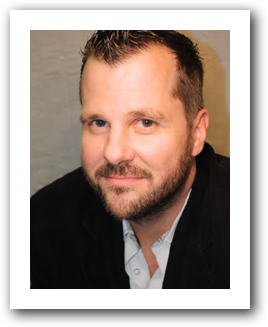 My Secret Formula For Explosive Growth Of Your Podcast
My Secret Formula For Explosive Growth Of Your Podcast
Platform
(be sure to read this story in a “tales from the crypt” creepy voice for added effect)
This approach focuses on selecting the best guests for your show while quickly building a large following and profitable Platform.
First create a master list of every potential guest that you would like to have on your show (don’t hold back). A great way to do this is look at similar podcasts and collect the names of their guest.
The second step is to look at the Klout scores of each guest and post the details in Column A next their name in a spreadsheet, while adding a new column for Twitter, LinkedIn, Facebook, Google+ and a description of their specialty (from LinkedIn).
The Third step add their followers or connects for each column.
The Fourth Step is to make sure they align with your audience by reviewing their speciality.
The Fifth step is to color the guests’ name Red when they do not align with your shows focus.
The Sixth step is to place an A, B, C or D by each one, based on your perception of their social influence.
The Seventh is to start with the D’s first (while honing your skills and show format) and work your way up to the top. You’ll come to understand the do’s and don’ts with each new episode you create.
The final step is to stay in touch with each guest and build an authentic relationship based on helping one another. This will quickly build a loyal following of listeners while positioning yourself and one of the industry leaders through your show.
This strategy uses several compounding elements of success. I’ll list a few to better illustrate what’s happening behind the scenes. “The tipping point” is coming into play due to reviewing and selecting guest based on the social scores and ability to spread the message. “The law of reciprocation” comes into play because you are offering your help to grow their reach (through your show), so they normally will reciprocate (if you are sincere in your actions).
Your “Positioning as the industry expert” comes into effect due to your show and its guests, equal a greater value as a whole.
Travis Lane Jenkins is the founder and owner of service and consulting businesses with more than 70 million dollars in sales. Travis is the co-host of “Diamonds In Your Own Backyard” The Entrepreneurs Radio Show, filled with inspirational stories that explain the tipping point that took high level Entrepreneurs from frustration to success with an emphasis on what’s working right now!
Allow The Interview to Flow, But Focus on One Topic for the Blog Post
 I do an interview style show and one of the things I really try to do is add something insightful to the conversation.
I do an interview style show and one of the things I really try to do is add something insightful to the conversation.
I do have a loose script but allow the interview to go anywhere that seems interesting.
Then, instead of just adding show notes I try to peg the entire discussion around making one key point in the accompanying blog post.
John Jantsch is a speaker, marketing consultant, award winning social media publisher and author of two Wall St Journal best selling books – “Duct Tape Marketing – The World’s Most Practical Small Business Marketing Guide”and The Referral Engine – Teaching Your Business To Market Itself.
You Can Profit From Podcasting!
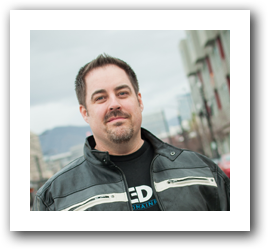 Making money from your podcast is very possible, but there are some very specific action plans that need to be taken first.
Making money from your podcast is very possible, but there are some very specific action plans that need to be taken first.
First of all, What do I know?!
My podcast, Internet Business Mastery, has been the ranked the #1 podcast in the incredibly crowded and competitive categories of internet business and marketing since 2005 and has made over 2.2 million dollars.
Along this exciting and wild ride, I’ve learned a few things about creating value and receiving money in exchange. Here are a couple of things I’ve learned:
Action Plans That Lead to Podcasting Profits
1. Find the pain
First you identify your audience’s pain so you can solve it for them. One of our students, Darline, did that with her site MamasOnBedrest.com. She found all the pain behind pregnant women confined to bedrest, so that she could find all the solutions to pain, creating massive value.
2. Believe in the value you have to offer
Share the story of how you, or someone you are close to, had the exact same pain or problems that the audience has. Save the details of how you overcame the challenges surrounding the pain for action plan #5. When we share our stories, the audience will benefit.
Darline constantly gets emails from mothers that thank her for her stories and hope and even consider her story part of what saved their babies. Embrace your story to continue creating value.
3. Build a Relationship
Telling your story will help build a relationship with your audience, but you must also empathize with what they are going through and connect with them. Here are some ways to do that.
- Encourage them to comment on your show by asking questions. Then respond to each comment and question. You can even do respond on your podcast.
- Survey them to narrow down the issues, so you can empathize and speak directly to them and their issues with the content of your podcasts.
- Paint a picture of what their world will be like once the pain is gone.
4. Chose a Money Model
There are many models for making money with podcasting, but here are a few:
- E-book
- Coaching Calls
- Membership Site
- Multi-Media course
- Affiliate products
If you’d like more information on these models and generating profit from podcasting, please check out the videos and action guide here at no cost: InternetBusinessMastery.com/CreateValue
5. Clearly Define the Solution
It’s time to clearly solve the pain your audience has and profit from creating that solution.
Let’s use creating an e-book as our example here. How would you create it?
You could start by having 10 simple chapters. The first 5 chapters would be answering the 5 top questions your audience has about solving their pain. Chapters 6-10 could be answering the 5 top questions your audience SHOULD ask about the pain, but doesn’t know they should ask.
There you go, you have an e-book you can be proud to charge money for. If you did all the others steps above, people will gladly pay you for the value you created.
There you go, 5 simple steps for profiting from your podcast. You can do it, you should do, and if you put yourself out there and create massive value, you can not only change people’s lives – you can make an incredible living at it!
Jeremy Frandsen is the founder and co-host of the Internet Business Mastery podcast. He is on a mission to assist others in finding what they are most passionate about and turning that passion into financial freedom.
Podcasting Takeaways
There you have it…thirteen podcasting tips from the experts.
Do you podcast? Do you have a tip or piece of advice you can share? If so, let us know your best tip in the comments section below.
And if you haven’t yet, please sign up for free updates delivered right to your email inbox.
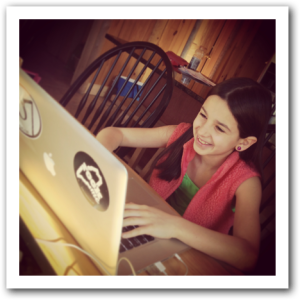 Oh, and one last shout out…I want to thank my beautiful daughter Sophie who helped me put together this post!
Oh, and one last shout out…I want to thank my beautiful daughter Sophie who helped me put together this post!
Not only did she copy and paste most of the tips into the post, she also did some Photoshop work as well.
Great job, Soph!

